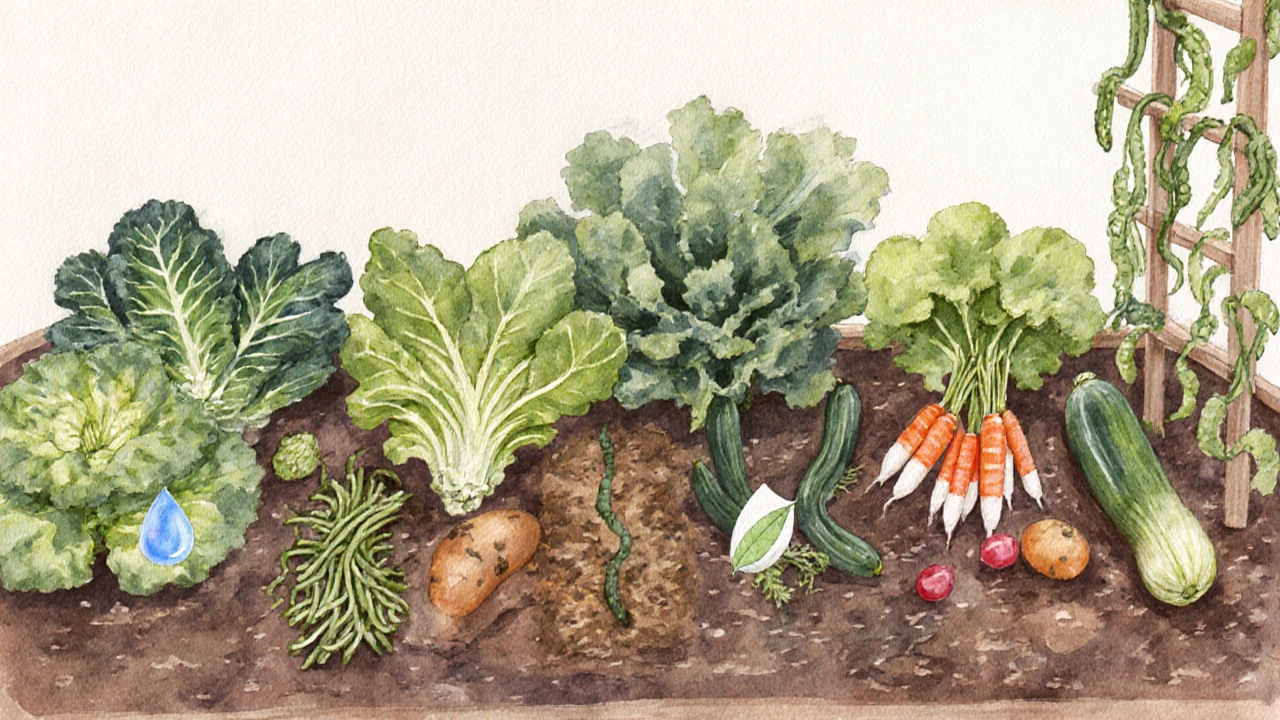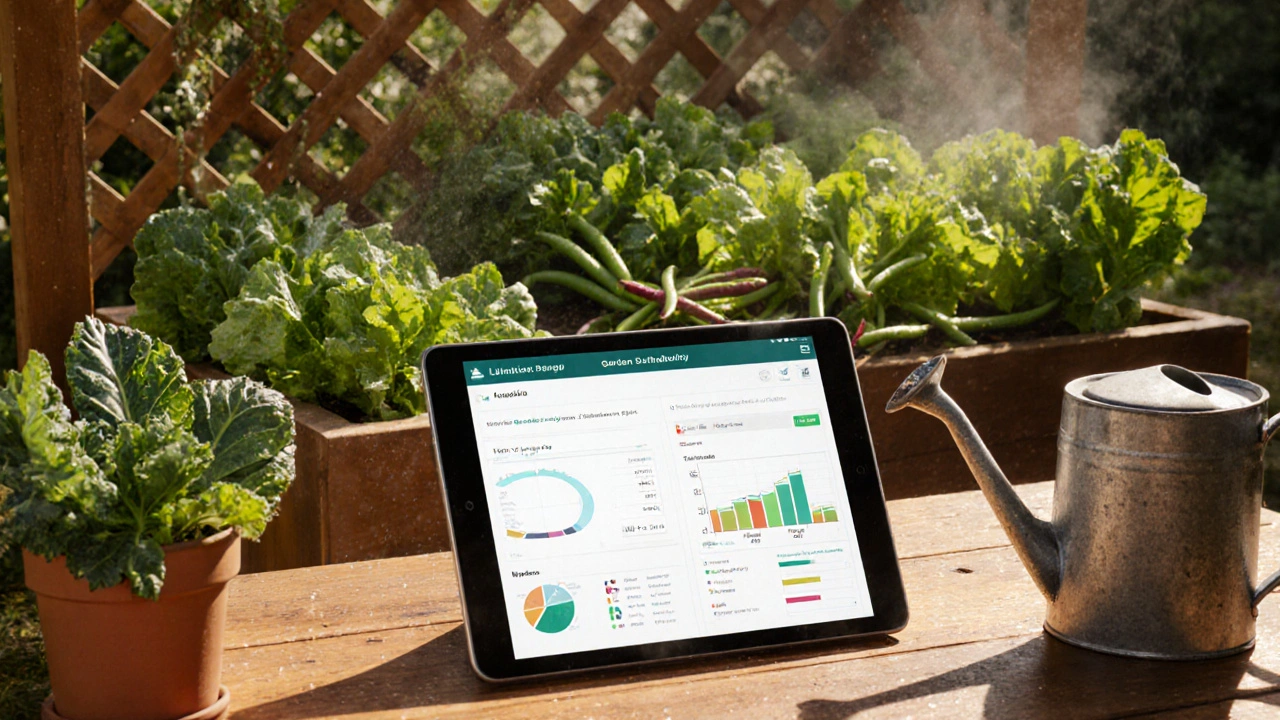Garden Sustainability Calculator
Your Garden Sustainability Report
Enter your vegetables and click "Calculate Sustainability Impact" to see your garden's environmental footprint.
Quick Take
- Look for veggies that need little water, grow quickly, and stay in the ground year‑round.
- Kale, lettuce, and beans top the list for low carbon footprints.
- Choose varieties that match your climate and soil type to avoid extra inputs.
- Companion planting and mulch cut water use by up to 40%.
- Track your garden’s impact with a simple water‑and‑CO₂ calculator.
What makes a vegetable ‘sustainable’?
When we talk about a sustainable vegetable, we’re not just looking at taste. Sustainability blends three core factors:
- Resource efficiency - how much water, fertilizer, and land the plant needs.
- Carbon impact - greenhouse‑gas emissions generated from seed production to harvest.
- Ecosystem friendliness - whether the crop improves soil health, supports pollinators, or resists pests without chemicals.
Think of it as a scorecard. The higher the score, the greener your garden.
Top eco‑friendly vegetables for a low‑impact garden
Below are the veggies that consistently score high on the sustainability card. Each entry includes the first‑time microdata markup so search engines can recognise the entity.
Kale is a cold‑tolerant leafy green that thrives with minimal fertilizer and can be harvested throughout winter. Kale’s deep roots pull up nutrients from lower soil layers, reducing the need for extra compost. A single head can produce up to 2kg of greens per plant, giving you a high yield for a tiny footprint.
Lettuce (leafy lettuce) is a fast‑growing, low‑water crop that can be harvested in as little as 30days. Because it matures quickly, lettuce requires fewer pesticide applications and fits perfectly into succession planting schemes.
Beans (especially dwarf bush varieties) are nitrogen‑fixing legumes that enrich the soil while producing protein‑rich pods. Their ability to add nitrogen cuts down on synthetic fertilizer use, a major source of greenhouse gases.
Carrots need loose, well‑drained soil but are otherwise low‑maintenance and store well for months. Their long growing season spreads the carbon load over time, and they can be sown multiple times a year in temperate zones.
Zucchini is a prolific summer squash that yields heavily from a single plant, meaning you plant fewer seedlings per square metre. Its high water‑use efficiency (about 200Lkg⁻¹) makes it a smart choice for rain‑fed gardens.
Potatoes are a calorie‑dense tuber that grows well in cool climates and can be harvested with a simple lift. When grown in raised beds with straw mulch, they need very little irrigation.
Radish is a quick‑turnover root vegetable that can be ready in 3‑4 weeks, meaning you can cycle crops fast and keep the soil active. Its shallow roots limit the amount of soil disturbance.
Peas (snap or shell) are another nitrogen‑fixer that climbs trellises, saving ground space. Peas thrive on moderate moisture and can be interplanted with other crops to maximize land use.
How the top picks stack up - a quick comparison
| Vegetable | Water use (Lkg⁻¹) | Carbon footprint (kgCO₂ekg⁻¹) | Nutrient density* (points) | Growing season (weeks) | Soil impact |
|---|---|---|---|---|---|
| Kale | 150 | 0.4 | 8 | 8‑12 | Low (adds organic matter) |
| Lettuce | 120 | 0.3 | 6 | 4‑6 | Low |
| Beans | 200 | 0.5 | 7 | 10‑14 | Medium (fixes nitrogen) |
| Carrots | 180 | 0.6 | 7 | 12‑16 | Low |
| Zucchini | 200 | 0.7 | 5 | 8‑10 | Low |
| Potatoes | 250 | 0.8 | 6 | 12‑14 | Medium (requires loose soil) |
| Radish | 140 | 0.3 | 5 | 3‑4 | Low |
| Peas | 210 | 0.5 | 6 | 10‑12 | Low (nitrogen fixer) |
*Nutrient density scores are based on a composite of vitamin A, C, K, iron, and calcium per 100g.

Choosing the right sustainable veggie for your garden
Start with a simple decision tree:
- Do you have a sunny spot (6+hours)? -> Pick kale, beans, or zucchini.
- Is water a limiting factor? -> Go for lettuce, radish, or kale, which need the least irrigation.
- Do you want a quick harvest? -> Lettuce, radish, and baby carrots give you greens in weeks.
- Are you looking to enrich the soil? -> Beans or peas will add nitrogen.
Match the answers to the vegetable list above and you’ll end up with a mix that feeds you, the soil, and the planet.
Practical tips for low‑impact growing
- Mulch everything. A 5‑cm layer of straw or leaves cuts evaporation by up to 40% and suppresses weeds.
- Rain‑water harvest. Connect a simple barrel to your downpipe; most UK gardens can store enough for a dry spell.
- Companion planting. Pair beans with corn or kale with aromatic herbs to deter pests without sprays.
- Crop rotation. Move nitrogen‑fixers into a different bed each season to keep soil microbes happy.
- Use heirloom or local varieties. They’re adapted to regional climates and often need fewer inputs.
Common pitfalls and how to avoid them
Even the most sustainable veggie can turn into a resource hog if you slip up:
- Over‑watering. Check soil moisture by sticking your finger 2cm deep; if it feels damp, hold off.
- Planting too dense. Crowded rows cause competition for nutrients, pushing you to fertilise more.
- Ignoring soil health. Skip soil testing and you might miss pH imbalances that force you to add lime or sulphur.
- Choosing the wrong season. Planting a heat‑loving zucchini in a cool, wet spring wastes space and water.
Next steps - track, tweak, and celebrate
Put a simple log in your garden shed. Note water used per watering, harvest weight, and any fertilizer spikes. After the season, calculate total CO₂e using the figures in the table above. You’ll see instantly where the biggest gains are.
Share your results on a local gardening forum or with a neighbour. Sustainable gardening is contagious - the more people see real numbers, the faster the change spreads.
Frequently Asked Questions
Which vegetable uses the least water?
Radish tops the list, needing around 140L of water per kilogram of edible yield - roughly 20% less than most other common garden veggies.
Do legumes really improve soil?
Yes. Beans and peas host rhizobia bacteria that convert atmospheric nitrogen into a form plants can use, cutting synthetic fertilizer needs by up to 30%.
Can I grow kale in a balcony garden?
Absolutely. Dwarf kale varieties fit in 30‑cm deep containers. Use a good-quality potting mix, water regularly, and you’ll harvest leaves all winter.
How do I calculate my garden’s carbon footprint?
Add up the CO₂e values from the table for each kilogram you harvest, then subtract any carbon saved by avoiding store‑bought produce (average 2kgCO₂e per kg of supermarket veg).
Is it worth composting for a small garden?
Yes. A modest kitchen‑garden compost can supply 10‑20% of the nitrogen you’d otherwise buy, lowering both cost and emissions.

